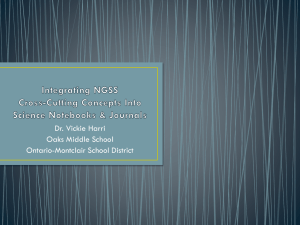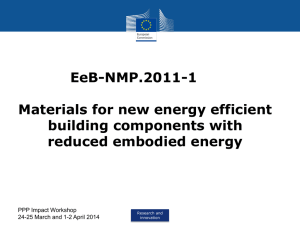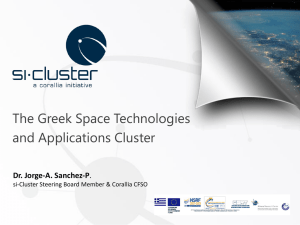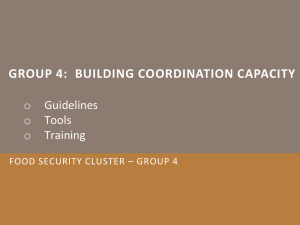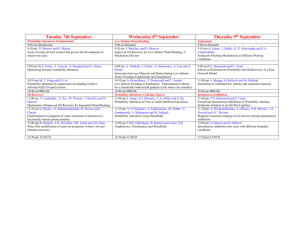Area 3 140314
advertisement
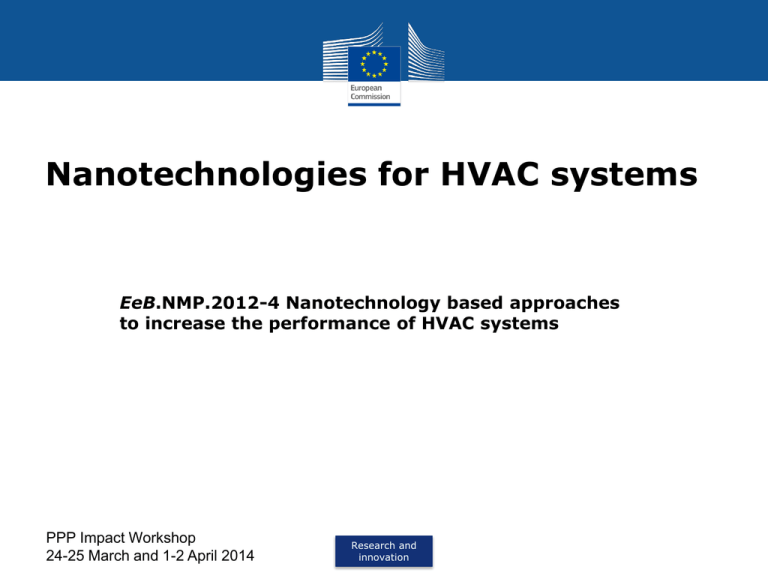
Nanotechnologies for HVAC systems EeB.NMP.2012-4 Nanotechnology based approaches to increase the performance of HVAC systems PPP Impact Workshop 24-25 March and 1-2 April 2014 Research and innovation S/T goals of the supported area Different technological solutions based on nanotechnology in order to: - Contribute to a reduction of the overall energy demand via nanotechnological solution - Improve HVAC systems or building components performance both for the cooling and heating mode - Reduce the global warming effect of HVAC systems Research and innovation Expected impact of the supported area - Demonstration at industrial system level - Increased quality of the indoor environment - Optimised heat exchangers for energy efficiency are expected to reduce energy consumption by 50% relative to similar conventional systems - Shift to non-fluorocarbon refrigerants in order to reduce impact on global warming Research and innovation Achieved/expected impact •Hybrid Liquid Desiccant cooling system • • • (NANOCOOL) Latent load removed by a liquid desiccant dehumidifier (LiCl-water) Sensible load removed by a conventional vapor compression air cooler Cleaning of air •Falling film absorber and regenerator: use of nanocoatings for improvement of wettability •Liquid-liquid heat exchanger: use of thermally conductive polymer nano-composites •Development of non-fluorocarbon refrigerants based on nanotechnology. Trials on Nanodiamond doped natural refrigerant are being conducted •Demonstration of reduced total service life costs for owners and occupants is expected in the next phases of the project. Nanocool system Research and innovation Improved wettability Achieved/expected impact • Improved air quality (bacteria, allergens) and increasing insulation (NanoHVAC) while maintaining a cost-effective solution: • • • • • Improved filters Efficient and cost-effective cleaning systems integrated in an automatic system Improved insulation with increased fire resistance Integration of the developments in the automatic manufacturing process Increased heat transfer efficiencies by the use of • • • (EnE-HVAC) Nanostructured surfaces have been developed at lab-scale and full-size heat exchangers produced for test Nanofluids have been developed for use as brines. Tests on large-scale systems expected to start very soon Nanotechnological coatings for anti ice formation is under development with promising results Research and innovation EnE-HVAC: Achieved/expected impact Activities for dissemination/exploitation •Dissemination with a focus on the “green angle” of the technology development including feasibility and costs effectiveness •Good industrial network ensuring dissemination of project results to a wider industrial audience. This includes publication in trade journals, company magazines, etc •Scientific dissemination through workshops, scientific publications and conferences Research and innovation Technical cross-cutting issues What technical cross-cutting issues among your projects should be taken into account to increase the overall impact? - Nanotechnologically enhanced coating for different purposes: * Increase wettability of surfaces * Increase heat & mass transfer * Anti-icing surfaces on air heat exchangers * Improved condensate drainage - Air Quality considerations Research and innovation Technical cross-cutting issues What technical cross-cutting issues among your projects should be taken into account to increase the overall impact? - The technologies from the different project can be combined for a better « total » solution: *Nano-based dissicant for removing moisture (nanoCool) *Anti ice surfaces (EnE-HVAC) *Air quality/antibacterial and isolation (nanoHVAC) Research and innovation Non-technical cross-cutting issues What non-technical cross-cutting issues among your projects should be taken into account to increase the overall impact? Market study and cost-efficiency Use of current standards to implement the solution in commercial buildings Safety aspects: nanoparticles, installation, air quality, extraction of experience from demonstration Legislation/approvement aspects regarding the use of nanomaterials for HVAC systems Research and innovation Synergies and benefits of clustering What cluster activities have you undertaken in the last year? Cluster meeting at Euronano forum June 2013 NanoE2B Cluster meeting in Wurzburg, Nov 2013 Signed NDA for the entrance into the nano-E2B cluster Considerations/discussions on how the project can gain from each other How have cluster activities added value to your projects? Awareness of other technologies (from other projects) Additional promotion of dissemination Common presentation organized for dissemination of the cluster activities How can cluster activities help exploitation of results after the projects end? Be combining technologies for larger impact The results are disseminated to a larger audience More industrial partners will be made aware of the work done in the cluster Research and innovation
